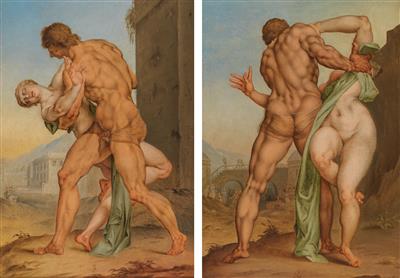Dutch School, first half of the 17th Century

The Rape of the Sabines,
oil on copper, each 43.5 x 30.4 cm, framed, a pair (2)
The present pair of coppers are a graphic testament to the exchanges between the Low Countries and Florence at the turn of the sixteenth century. In particular, the meticulous handling and in-the-round modelling of the pair exude the brilliance of the two Northern mannerist sculptors, Adriaen de Vries (circa 1556–1626) and his master Giambologna (1529–1608). Giambologna’s Rape of the Sabines (circa 1583) was arguably the first ever work of abstract sculpture, being an exercise in interlocking human form, only later sanitised with a mythological title at the demand of the Grand Duke Francesco I de Medici. Diffused through engravings such as Jan Muller’s circa 1627 treatment of the same subject conserved in the Metropolitan Museum, New York (inv. no. 59.642.21), to designs by de Vries, the development in the present pictures of the early Roman architecture and the addition of staffage such as the horseman bearing away his captive in the landscape background lends a greater antique credence to the otherwise highly eroticised subject.
Esperto: Dr. Alexander Strasoldo
 Dr. Alexander Strasoldo
Dr. Alexander Strasoldo
+43 1 515 60 403
old.masters@dorotheum.com
09.06.2021 - 16:07
- Stima:
-
EUR 18.000,- a EUR 30.000,-
Dutch School, first half of the 17th Century
The Rape of the Sabines,
oil on copper, each 43.5 x 30.4 cm, framed, a pair (2)
The present pair of coppers are a graphic testament to the exchanges between the Low Countries and Florence at the turn of the sixteenth century. In particular, the meticulous handling and in-the-round modelling of the pair exude the brilliance of the two Northern mannerist sculptors, Adriaen de Vries (circa 1556–1626) and his master Giambologna (1529–1608). Giambologna’s Rape of the Sabines (circa 1583) was arguably the first ever work of abstract sculpture, being an exercise in interlocking human form, only later sanitised with a mythological title at the demand of the Grand Duke Francesco I de Medici. Diffused through engravings such as Jan Muller’s circa 1627 treatment of the same subject conserved in the Metropolitan Museum, New York (inv. no. 59.642.21), to designs by de Vries, the development in the present pictures of the early Roman architecture and the addition of staffage such as the horseman bearing away his captive in the landscape background lends a greater antique credence to the otherwise highly eroticised subject.
Esperto: Dr. Alexander Strasoldo
 Dr. Alexander Strasoldo
Dr. Alexander Strasoldo
+43 1 515 60 403
old.masters@dorotheum.com
|
Hotline dell'acquirente
lun-ven: 10.00 - 17.00
old.masters@dorotheum.at +43 1 515 60 403 |
| Asta: | Dipinti antichi II |
| Tipo d'asta: | Asta online |
| Data: | 09.06.2021 - 16:07 |
| Luogo dell'asta: | Wien | Palais Dorotheum |
| Esposizione: | 29.05. - 08.06.2021 |
